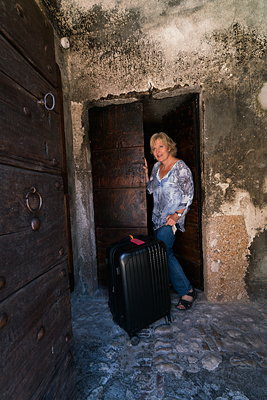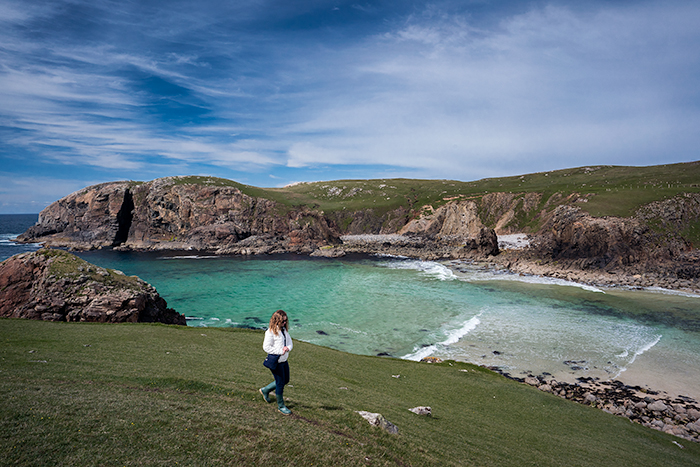Tourists seeking an alternative travel destination to the popular Isle of Skye should consider venturing further to the Isle of Lewis in the Outer Hebrides.
Top Reasons to Visit the Isle of Lewis…
- Be among sheep instead of crowds–it’s quiet and relatively unknown
- Explore miles of empty white-sand beaches
- Wander through unique archaeological ruins
- Touch the world’s oldest standing stones
- See Scotland’s most famous find that was uncovered here
- Hear locals speak Gaelic
- Learn about crofting & Clearances
- Watch crofters weave Harris Tweed (only place in the world it’s made)

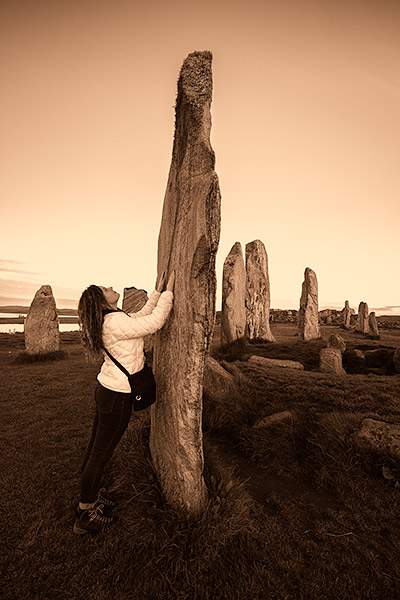
Geography on the Isle of Lewis
The Isle of Lewis is the largest land mass in a string of islands along the 124 mile archipelago 30 miles off the far northwest coast of Scotland. It is separated into two parts, Lewis and Harris, by type of terrain.
Lewis, the largest part of the island, is primarily flat. Peat bogs, up to 15 feet deep, cover the interior. Locals cut peat in the spring and dry out blocks for heating their homes. Grazing land nourishes long-horned cattle and thousands of black-faced sheep shorn for Harris tweed. Machair coastal grasses grow near the sea. The only town on the island is Stornoway, which is home to one third of the population.
In contrast, Harris, the far smaller part of the island in the south, has a spine of rocky mountains and lunar terrain. Gorgeous white sandy beaches stretch along the entire western coast, where massive cliffs take the brunt of the swelling surf, creating powerful waves from the mighty Atlantic Ocean. The Lewisian gneiss rocks dating from the Precambrian period–oldest in the world—forms fantastical sea stacks near Uig and Mangersta. Other unusual igneous outcroppings include anorthosite, a rare whitish rock common on the moon.
Average temperatures range from 39-61 F. Not so cold when you realize just how far north this island is located. But, the chilling wind–with no trees to break its speed or force–makes it feel much colder. Bring fleece layers! Clouds often dominate the sky, creating vivid sunsets or dark, moody scenes.
Is the Isle of Lewis for me?
Deciding where to travel is akin to choosing a dog for your pet. Aside from looks, pedigree and personality, a pet’s energy level is most important to consider–as it should match yours. Are you mellow or high-energy? A spirited breed that needs constant stimulation and daily runs is a poor choice if you prefer to veg after work and watch tv. Travel is the same. Not every destination is for everyone…

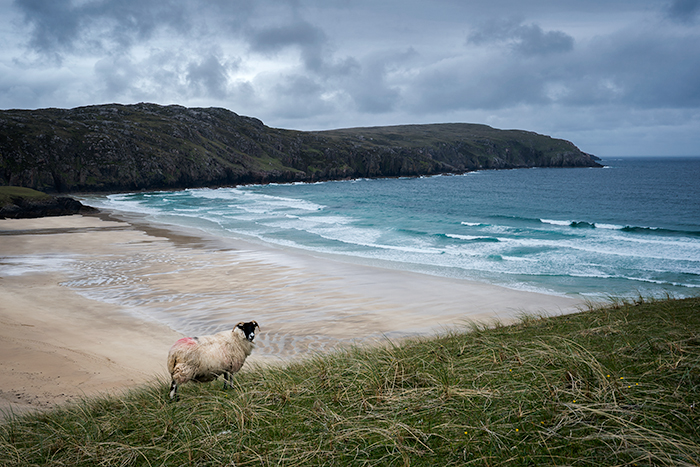
Harris beach with a welcoming sheep!
The Isle of Lewis in the Outer Hebrides will appeal most to those who prefer remote isolated places. Do you like driving across wild, rugged and beautiful landscapes, exploring at an unhurried pace? Do you enjoy delving into ancient history, and peeking inside the cultural traditions that define a special place?
If you travel here after seeing a pictures of white sandy beaches expecting to spend lazy days sunbathing at tropical beaches–well, stop. This is not the Caribbean. Glance at a map. See how far north it is? Expect coasts to be very windy and cold. And not great for swimming. Unless you can brave freezing water.
The Isle of Lewis is not the destination for those who prefer a frenzied pace, urban life, organized tours, and lots of restaurant choices. Or the convenience of hiring an Uber to zip between sites and back to your hotel.
Instead, this is an off-the-beaten path kinda place where you’ll feel like an explorer.
There are amazing sites but you’ll have to work a bit harder to find them. Think of it like a scavenger hunt.

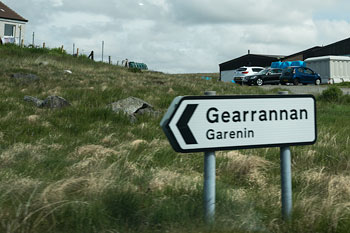
There’s no neon signs to mark your way. Just short black and white signs in Gaelic (sometimes English too) erected at the intersection of a turn. And, you’ll need to be comfortable driving on the right side of the car over narrow singletrack roads that curve around blindly without any shoulders to veer off onto in case of approaching traffic or crossing sheep.
The main tourist attractions below are easily accessed from a paved road. There are sooo many other places to venture that I didn’t include. Some, honestly, we never could find. But isn’t that half the adventure?


Attractions
If you want an idea of how to fit in the following sites in a single day, check out my post Ancient Sites to Visit on the Isle of Lewis as I suggest an itinerary with route, times needed to travel sightsee, and other tips.
Beaches

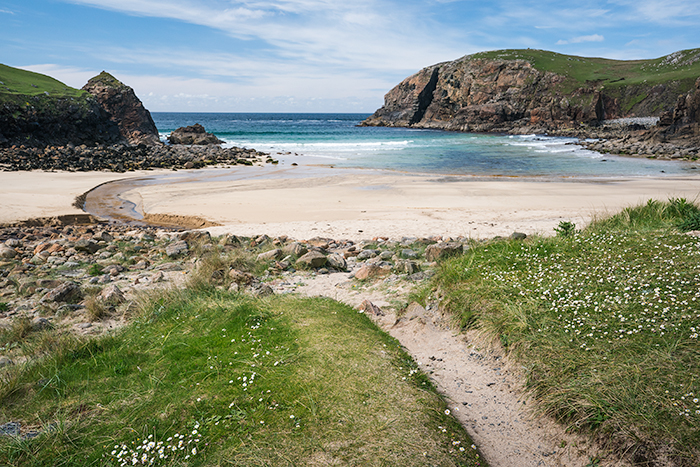
Dalbeg Beach, Isle of Lewis
Wind swept beaches edged with machair grasses seem to extend for miles along the western coast. You can easily visit Dalbeg the same day you visit other main attractions below. But you’ll want another day to fit in Uig Sands where the chessmen were found, and another closeby like Reef beach.
Or drive the Golden Road loop around Harris in the southern part of the island. Numerous beaches exist. Some are visible from the main road–simply park and explore what catches your eye. One of my favorites was Scarista beach off A859 after leaving Rodel. This beach had short dunes to climb before reaching an expansive lonely stretch of sand we had all to ourselves. Other beaches require driving to, including the most famous on the island, Luskentyre (voted top ten most beautiful beaches in the world). Along this road to Luskentrye you’ll see Horgabost beach and Seilebost beach with tall sand dunes. Keep traveling toward Tarbert and you’ll find other unnamed beaches with rocky coasts with rock faces to climb down to access the pretty coves.
Callanish Standing Stones

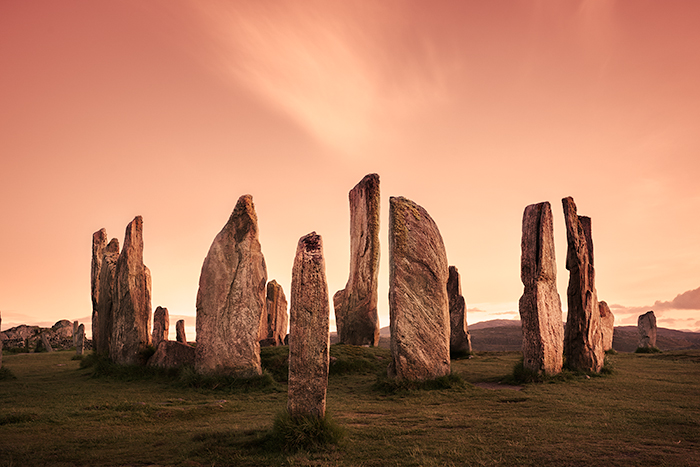
Isle of Lewis standing stones
Older than Stonehenge. And you can touch them! Wander around them at whim all day or night–they exist on a hill and not fenced in! Circle of 13 stones surround a 32 foot stone in the center, all consisting of gneiss rock, one of the hardest and oldest rocks in the world. My favorite thing to photograph on the island. And I share my tips in this post.
Dun Carloway Broch

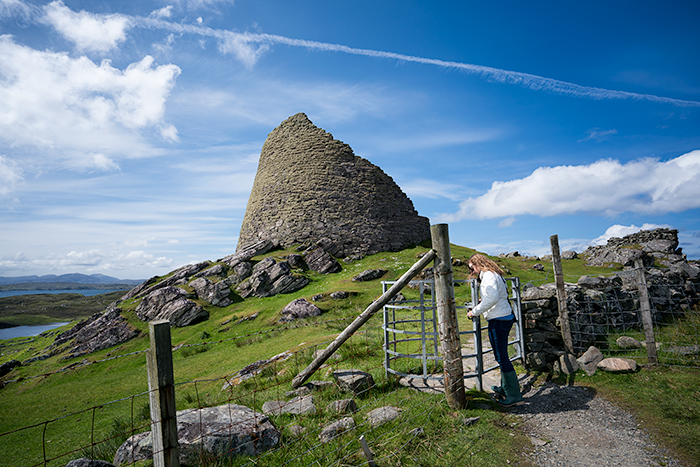
Dun Carloway is an impressive broch on the west coast of Lewis. This is Scotland’s best preserved broch, a fort-like structure from the Iron Age, likely built in the 1st century. This small stone tower likely housed a wealthy family. Tourists can walk around it, duck into the openings or climb the stairs in a hollow walled chamber to reach the top. Views of the surrounding landscape are stunning from here. Fairly quick stop close to Callanish & Blackhouses.
Gearrannan & Arnol Blackhouse Village


There are 2 blackhouses on the Isle of Lewis that tourists can visit to get a better understanding of how local people lived. These long stone homes had thick walls and thatched roofs and were heated by peat. One end housed people, the other animals. These dark sooted homes were inhabited until the 20th c when new rules about separating animals from human living. Gerrannan rents out rooms if you want to experience living like locals did (but prepared for sour smoke smells from the peat).
Lewis Chessmen

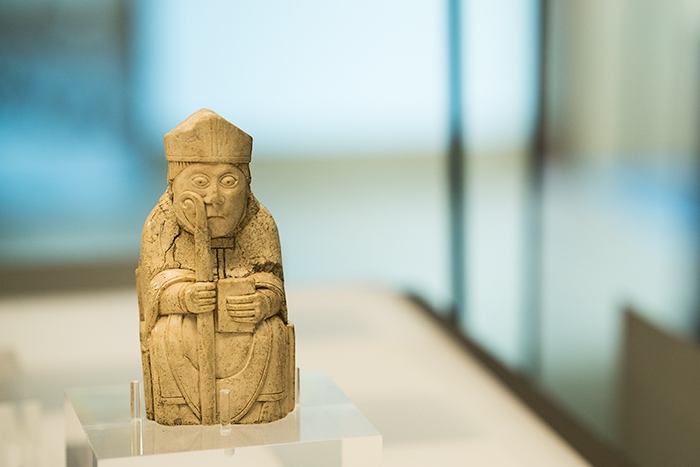
Bishop chess piece, Lews Museum
Lewis Chessmen were discovered at Uig Sands back in the 1800’s. The bizarre pieces dating from the 12th century represent one of Scotland’s most important archeological finds. The chess pieces are split between prominent musems. Tourists can see them in London, Edinburgh and tiny Lews Museum in Stornoway here on the island.
Harris Tweed

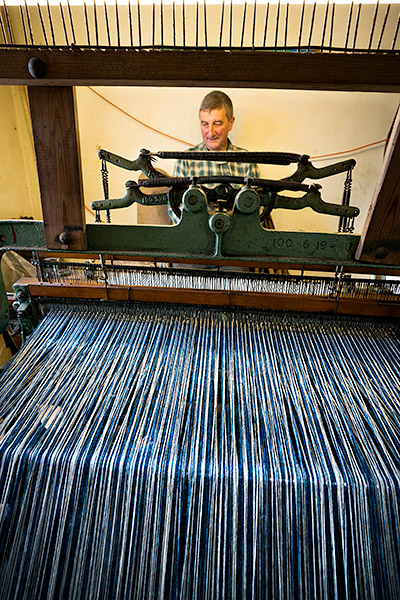
A unique product produced fully on this island and no where else in the world! Watch weavers in their sheds busy at their foot-pedaled looms or at a few attractions around the island or port towns. My Harris Tweed post describes the process from shearing sheep to store with photos of Kenny one of noted weavers on the Isle of Lewis.
Hiking Adventures
There are numerous places to explore around the island, from long rambles along lonely beaches or cliffside coasts and also established hiking trails. See references below for books with detailed hiking descriptions. Here are 2 on each end of the island to consider.
West Coastal Path at Dalbeg Beach (Lewis):


Hike along the western coast of the Atlantic Ocean heading either north or south from the car park. Look for wooden trail head marking on the grassy bank and head up the hill. Heading south you can hike the 4 mile (3 hour) trail all the way to Gaerrannan Blackhouse, or 40 minutes to Dalmor beach. Some of this trail leads over high cliffs but most of it travels through moorland.
Hiking north you’ll follow the cliffside with crashing surf below and end up at a grassy peninsula jutting out into the ocean. We hiked this trail looking for the sea stacks at Pris-a beach but never found them. Go as far as you want and return to the carpark. Think of these as out and back trails. (If you want to attack the entire 12 mile West Coastal Path check out the WalkHighlands webite for detailed info.)

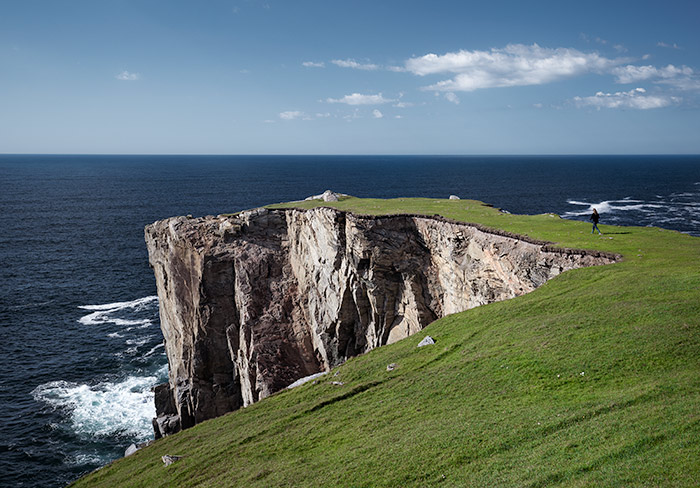
Norse Watermills (Lewis)
This is a short one hour hike from Reef Beach in Valtos, near Uig. There is no trail head marker. Look for the fence across the street from the car park, enter the gate and head north toward the back wall of rocks. You’ll pass through rocky terrain that leads up a rocky hill and ends at a small lake. Along the way note the 2 ancient Norse stone watermills near the path. This hike is described as a ‘romp through Narnia’ that ends with stepping stones to cross the lake at low tide. Out and back trail.
We hiked this trail in the rain, which made the traverse a bit tricky on slippery rocks. When we reached the lake, the surrounding moor was quite boggy and the stepping stones were not visible.
Postman’s Trail (Harris)
This 3 hour trail traverses between the tiny hamlet of Rhenigidale (1 hour off the main road) and Tarbert. Once upon a time a postman made this trek twice a week to deliver the mail. The trail veers around an abandoned village along the Atlantic coast and up a zigzagging twisting path through the mountains all the way to the port of Tarbert. However, like any other trail, you can go as far as you want and turn back. Beware that the access road is very tiny and might discourage you from attempting to reach Rhenigidale. (Curious that there’s a hostel there but no bus service.) Easier trailhead access is from Tarbert, but the most stunning scenery is near Rhenigidale.
Coffin Trail (Harris)
This 4 mile trail begins at the Bays (7 miles south of Tarbert) and leads to famous Luskentyre beach. The trail winds through a stark bare landscape shaped by beaches and bays where families were forced to live during the Clearances. Ironically, their graves are located on the opposite weatern coast where they were evicted from to make room for sheep.
History of Lewis
The Isle of Lewis is old! Earliest evidence of settlers dates from 8,000 years ago, and 5,000 yr old remains still exist on the island. Ancient stone homes belonging to the farmers are not so different than what exists today. During the Iron Age (500 BC), defensive forts and brochs were erected to protect inhabitants from who–we don’t really know!
Gaelic speaking Scots arrived on the Isle of Lewis in 1st c AD, and Christiantiy came to St. Columba thanks to a murderous clansman turned monk who built the church to atone for his many violent sins. Vikings invaded and conquered the island in 9th c. until Outer Hebrides islands were returned to the Scots in 1263 after King Alexander III defeated Norwegian King Haakon IV.
Following the failure of the Jacobite rebellion in 1745, when the British ruled Scotland, a turmultous time known as the Clearances affected the population on the islands, as locals were forced from their homes on the western side of the islands to make way for more sheep. Many emigrated to Canada or the US. In 1844, Sir James Matheson bought the entire island for $318,000 and began building roads and businesses. The population today is 18,500 people.
Industry
Fishing, farming and weaving are the main industries.
Once upon a time seamen were out at sea for 48 weeks a year — can’t imagine! Fishermen experienced dangerous conditions–rough seas, windy, freezing cold temps lasted weeks on end. The worst tragedy occured on New Years Day, Jan 1 2018 when the HMY ship struck rocks and sank within eyeshot of the Stornaway harbor where it was headed home.
Farmers raise black-faced sheep for Harris Tweed and long-horned cattle for exporting high quality beef. Farms are scattered throughout the island and sheep are visible everywhere –even wandering across the narrow roads when you least expect them. Quite a few expats from England have relocated here to take up farming in their mid- later years. We met a former Barrister from London who now raises sheep, and invited us into his home for tea after watching him whistle commands to his dogs to corral his sheep.

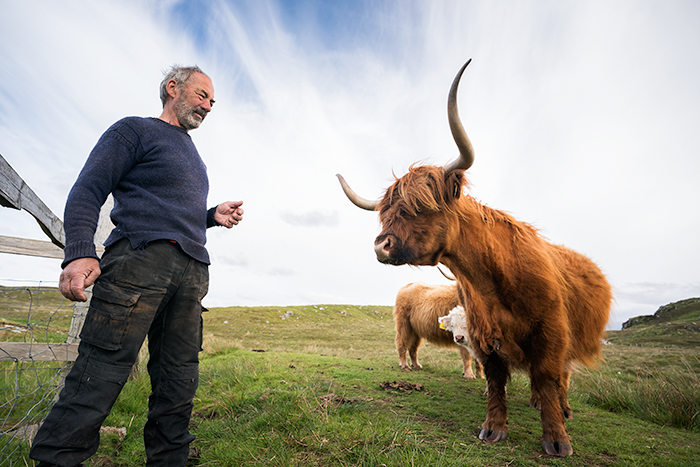
Harris Tweed weaving takes place fully on the Isle of Lewis. Only sheep from this island are used to produce the wool. Weavers work on foot-pedaled looms in sheds attached to their homes. Many of the looms are passed down through generations. Watch this tedious, time consuming process to better appreciate the beautiful end product you later buy in the store.

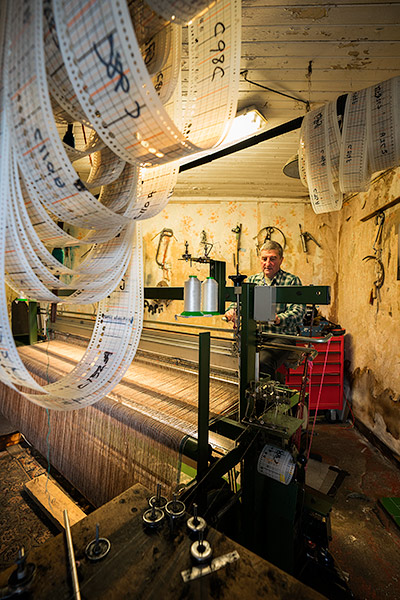
Lodging on the Isle of Lewis
Decide first and foremost what you want to do on the island. This will narrow down the best base as driving distances are long between beaches and sites on Harris and Lewis. Then decide if you want to be in the country or in town. Stornoway has by far the larger assortment of coffeehouses, restaurants, hotels, and evening entertainment if that’s important to you. On the opposite end of the island, Tarbert the other port has one hotel anda guesthouse, and a few places to eat.
But scattered across the island are cottages, farmhouses, and striking modern glass & stone guesthouses for rent in the countryside or near the sea. You can escape from reality with a stay at a lodge on the edge of a beach that took you all day to reach, and spend a week in complete isolation. Or stay in a 5 star guesthouse like the stunning minimalistic Rock House in Borve. Or rent a farmhouse or rustic cottage for a week. Or hike to a cliffside bothy– free to adventurous souls for a night. Or stay near your favorite attraction, such as one of two guesthouses near Callanish Stones to visit them early morning or midnight. These fill up quickly due to the popularity of proximity to this special site. Also, be advised that most cottage rentals require 5 nights or longer.

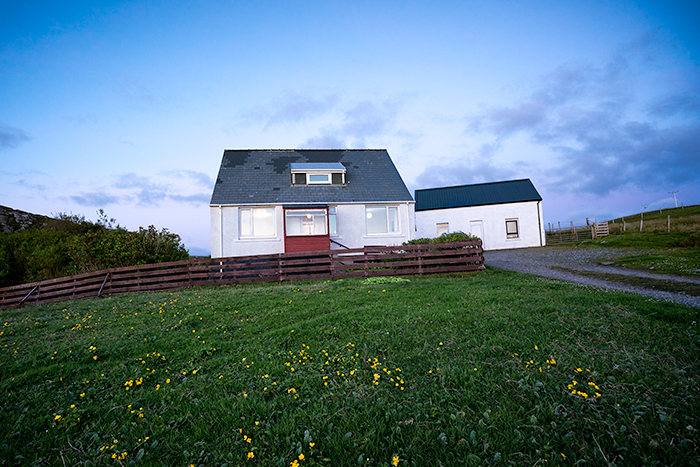
Weaver’s shed is adjacent to this farmhouse we rented
We stayed in Granny’s Home, a farmhouse on a working croft near Callanish Stones and loved our accommodations! The 3 bedroom 2 bathroom home attached to the crofter’s weaving shed, had everything we needed and more. Our hosts Kenny & Caroline left us fresh eggs, cheese and a bottle of wine to welcome us. We brought a few groceries from the mainland, knowing it would be a few days before we traveled to Stornoway. Good thing we did too, because there were very few places to eat around us. The Callanish Stones tourism center has a tiny cafe with egg or deli meat and cream sandwiches for lunch only, and a nearby tavern had dinner available about 10 minutes drive away.
There are a variety of booking services to reserve your stay, from Booking.com, vrbo, airb&B to holidayletting.uk. Part of the fun is searching online to see the unique offerings in this remote part of the world.
Side note about food: bring your own stash and cash! Restaurants and cafes are VERY limited on the island apart from Stornoway and Tarbert port towns. You’ll need cash to grab food from Takeaways. Locals erect these honor system boxes in random places. Leave cash and take either frozen meals to reheat later or refrigerated sandwiches to eat now.
We’d read of several gourmet Takeaways and made a point to travel to North 40 in Lewis (by Dalbeg beach) and Croft 36 in Harris (near Seallom Visitor Center)–but both were closed– permanently? We saw several tiny honor system boxes all over the island with single items to purchase artsy souviners like coasters or painted postcards, & food condiments like spicy mustard or honey. The only food we found was raw salmon and shellfish sold by a local farmer in Rodel who opened an impromptu food shack near the medieval church of St. Clements. That was the only place we found open to eat in Harris until we reached Tarbert that night. (And that was pre-Covid!)
HOW TO GET THERE
BY FERRY
Both Lewis and Harris have a ferry port. If coming from the Isle of Skye, you will leave from Uig and arrive at the Tarbert port on Harris, whereas the Stornoway port on Lewis serves Scotland’s northern mainland.
All of the islands in the Outer Hebrides are served by the Caledonian MacBrayne ferry service, where you can travel as a foot passenger, or with your car. Travel time from Uig (Isle of Skye) to Tarbert (Harris) is 1 hr 45 minutes verse 3 hours from the mainland to Stornoway (Lewis). Be aware that adverse weather can delay or cancel the service altogether, and that you need to book your ticket far in advance. Slots sell out surprisingly fast for those coming by car, so do not delay.
We found these large ferries to be a comfortable way to travel here. Plenty of room to roam around! Hot meals available eat in the dining room, and a spacious lounge with wraparound windows for relaxed gatherings, napping or playing cards. Observe the sea from fabric covered seats inside or plastic chairs on the outer deck.
We took the ferry from Uig to Tarbert port (Harris) then headed north to Lewis. We traveled up through the mountains in our rental car on single track road which leveled to flatter landscapes when we reached the invisible border of Lewis. Terrain looked desolate, remote, fairly bleak. The greenish-brown wilderness separated by dark inky lochs spread for miles. Occasionally we’d see a stone home alone in the stark landscape, the absence of trees making it appear lonely and uninhabited.
BY PLANE
Daily return flights operated by Loganair arrive in Stornoway from Benbecula, Glasgow, Edinburgh, and Inverness multiple times a day, and an additional flight service operates five days a week between Southend, near London, and Stornoway. Loganair also operates return flights to tiny Benbecula isle from Glasgow and Stornoway, and to Barra from Glasgow.
Guidebooks are essential to planning your perfect trip! Here are some of my recommendations…
This beautiful coffee table book by Peter May, tells his story and connection to this place where he filmed his TV series Machair.
What better way to get in the groove than to read novels set on these very islands? Best is Peter May’s trilogy murder mysteries.



